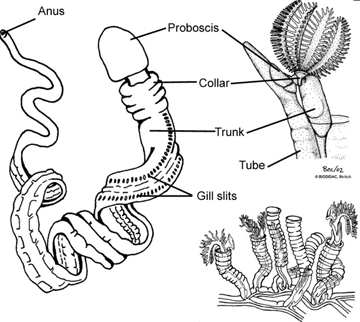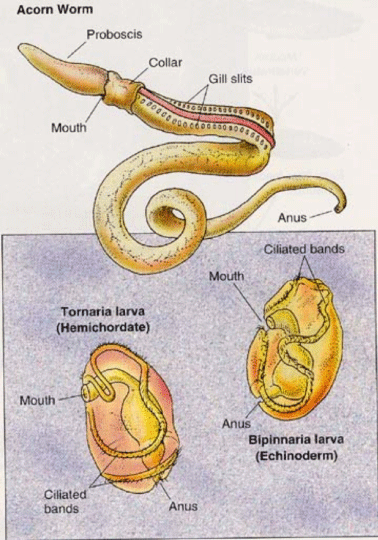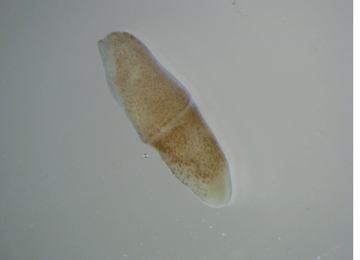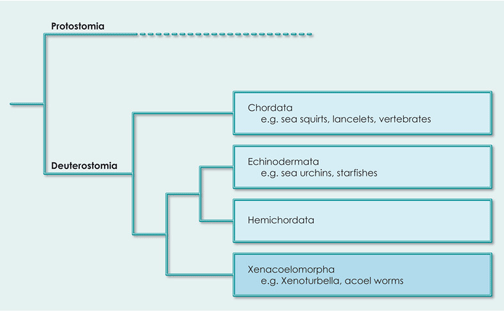
Hemichordates

Hemichordates are distinguished by a tripartite (threefold) division of the body. At the forward end of the body is a preoral lobe, behind this is a collar, and last comes a trunk (so 3 segments). Each contains a division of the coelom. The name "hemichordate" means "half chordate," and hemichordates share some (but not all) of the typical chordate characteristics. There are branchial openings, or "gill slits," that open into the pharynx; there is a rudimentary structure in the collar region, the stomochord, that is considered similar to a notochord by some authors (although develops differently from a notochord in the embryo and involves different genes); and there is a dorsal nerve cord, in addition to a smaller ventral nerve cord.
However, hemichordates are not classified as true chordates, although they are quite closely related. Some DNA-based studies of evolution suggest that hemichordates are actually closer to echinoderms than to true chordates. This is supported by the fact that the larvae of at least some hemichordates look very much like those of some echinoderms.

Acorn worms
Acorn worms live on the sea-bed, from the shoreline down to the depths of 10,000 ft.. (3,050 m)The skin is covered with cilia as well as glands that secrete mucus. Some produce a bromide compound that gives them a medicinal smell and might protect them from bacteria and predators.
Acorn worms move by cilia movements and body contractions. The stomochord provides support for the front of the animal and the coelom acts as a hydrostatic skeleton for the back. They are filter feeders.
The sexes are separate. Eggs and sperm are merely shed into the water and fertilization occurs by chance. Most eggs are very small and they produce small Larvae, which swim freely in the plankton for a short while before settling on the sea-bed.
In Hawaii, large acorn worms grow to 1 inch in diameter and are 18 inches long. They live in U-shaped burrows 30 feet or deeper. There, the big worms swallow large quantities of sand, digest any plant or animal material in it and then pass the sifted sand out behind. These fecal mounds look like coiled ropes of extremely fine sand. At a touch, the piles disperse like ash.
Acorn worms have a circulatory system with a heart that also functions as a kidney. The blood is colourless and has no respiratory pigments. It is forced through the animal's few vessels by the beating of a muscular heart that forces blood through the central sinus. The heart constricts the sinus, but the blood does not actually enter the heart so it is not a heart in the strictest sense. The blood passes through two longitudinal blood vessels and a series of sinuses.
Acorn worms have gill-like structures,similar to the gills of primitive fish, that the worms use for gas exchange.
Acornworms do not have rich fossil records, though fossils have been recognized fromthe Lower Triassic some 250 million years ago
Pterobranchs are also considered hemichordates
Pterobranchs are colonial hemichordates living in secreted tubular tubes. They are typically found in deep waters around Antarctica. They are small animals ranging in size from 1 to 12 millimetres in length. Pterobranchs live in much deeper water than the Enteropneusts, this and their soft bodies means that they are difficult to study.
Interestingly, they posses only one, or in some species no pharyngeal slits.
They reproduce by short-lived planula shaped larvae or asexual budding.
They may be descendents of graptolites. These are fossils whose affinities are unknown but date from the mid-Cambrian.
Xenoturbellids are small ciliated worms. The body structure resembles that of a acoel flatworm. There are no organs except a statocyst. A mouth is found near the middle of the animal, leading directly into the stomach. There is no pharynx and no anus.
Its nervous system is a simple nerve net, with no sign of a brain or any true nerve cords. The statocyst (st) at the anterior end of the animal has a nervous plexus associated with it, but that is the only form of nervous system centralisation found.
Two muscular systems are found. The main one is formed by a membrane complex running across the entire body. A second system is found around the stomach.

Their reproduction is very simple. They’re hermaphrodites with no gonads, genital openings or copulation rituals. Eggs and sperm originate in the tissie surrounding the intestine. Eggs break into the stomach and are transferred to the mouth and released; the same is presumed to happen to sperm.
Based on molecular data, they were at first thought to be related to Mollusks. Now we know that they eat mollusks.
New gene sequence analysis places them closer to echinoderms. They have a micro RNA that was previously only known to exist in echinoderms and acorn worms. Moreover, all of the animals analyzed up to now from the new clade have the gene RSB66, which could previously only be demonstrated in deuterostomes. Xenoturbellids' position as a stem or "ancestral form" to the deuterostomes is still debated; some may simply be an advanced form of some unknown clade. Others feel these worms are closely related to acoels and it is the acoels that should be moved closer to the deuterostome line and out of the Platyhelminthes.
